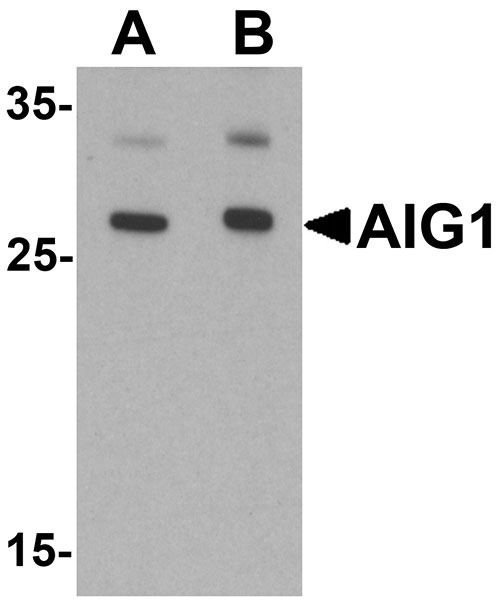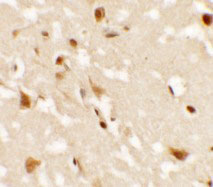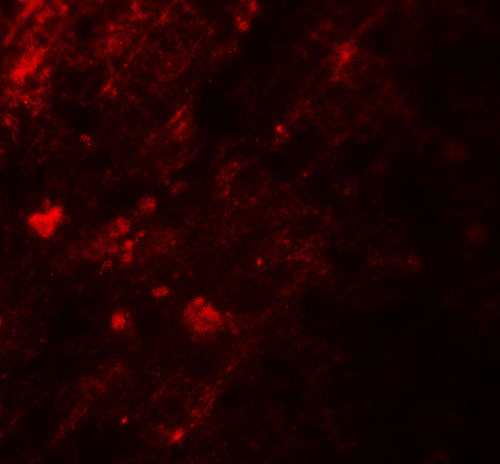AIG1 Antibody
- SPECIFICATION
- CITATIONS
- PROTOCOLS
- BACKGROUND

Application
| WB, IHC-P, IF, E |
|---|---|
| Primary Accession | Q9NVV5 |
| Other Accession | NP_057192, 40316941 |
| Reactivity | Human, Mouse, Rat |
| Host | Rabbit |
| Clonality | Polyclonal |
| Isotype | IgG |
| Calculated MW | 27458 Da |
| Application Notes | AIG1 antibody can be used for detection of AIG1 by Western blot at 1 - 2 µg/mL. Antibody can also be used for immunohistochemistry starting at 2.5 µg/mL. For immunofluorescence start at 2.5 µg/mL. |
| Gene ID | 51390 |
|---|---|
| Target/Specificity | AIG1; |
| Reconstitution & Storage | AIG1 antibody can be stored at 4℃ for three months and -20℃, stable for up to one year. As with all antibodies care should be taken to avoid repeated freeze thaw cycles. Antibodies should not be exposed to prolonged high temperatures. |
| Precautions | AIG1 Antibody is for research use only and not for use in diagnostic or therapeutic procedures. |
| Name | AIG1 |
|---|---|
| Function | Hydrolyzes bioactive fatty-acid esters of hydroxy-fatty acids (FAHFAs), but not other major classes of lipids (PubMed:27018888). Show a preference for FAHFAs with branching distal from the carboxylate head group of the lipids (PubMed:27018888). |
| Cellular Location | Cell membrane; Multi-pass membrane protein |
| Tissue Location | Highly expressed in heart, ovary, testis, liver, and kidney, at lower levels in spleen, prostate, brain, skeletal muscle, pancreas, small intestine and colon, and undetected in peripheral blood leukocytes, thymus, lung and placenta. AIG1 expression is higher in hair follicles from males than from females |

Thousands of laboratories across the world have published research that depended on the performance of antibodies from Abcepta to advance their research. Check out links to articles that cite our products in major peer-reviewed journals, organized by research category.
info@abcepta.com, and receive a free "I Love Antibodies" mug.
Provided below are standard protocols that you may find useful for product applications.
Background
AIG1 Antibody: Androgen-induced 1 (AIG1) is a novel Pirh2-interacting protein, which was initially cloned from human dermal papilla cells and is evolutionally conserved from drosophila through to humans. It is a membrane protein and belongs to the protein family containing FAR-17a domain. AIG1 may play a role in androgen-regulated growth of hair follicles. AIG1 could serve as a new biomarker for the diagnosis and prognostic evaluation of HCCs and may be a novel candidate tumor suppressor.
References
Wu G, Sun M, Zhang W, et al. AIG1 is a novel Pirh2-interacting protein that activates the NFAT signaling pathway. Front. Biosci. (Elite Ed). 2011; 3:834-42.
Seo J, Kim J, and Kim M. Cloning of androgen-inducible gene 1 (AIG1) from human dermal papilla cells. Mol. Cells 2001; 11:35-40.
If you have used an Abcepta product and would like to share how it has performed, please click on the "Submit Review" button and provide the requested information. Our staff will examine and post your review and contact you if needed.
If you have any additional inquiries please email technical services at tech@abcepta.com.













 Foundational characteristics of cancer include proliferation, angiogenesis, migration, evasion of apoptosis, and cellular immortality. Find key markers for these cellular processes and antibodies to detect them.
Foundational characteristics of cancer include proliferation, angiogenesis, migration, evasion of apoptosis, and cellular immortality. Find key markers for these cellular processes and antibodies to detect them. The SUMOplot™ Analysis Program predicts and scores sumoylation sites in your protein. SUMOylation is a post-translational modification involved in various cellular processes, such as nuclear-cytosolic transport, transcriptional regulation, apoptosis, protein stability, response to stress, and progression through the cell cycle.
The SUMOplot™ Analysis Program predicts and scores sumoylation sites in your protein. SUMOylation is a post-translational modification involved in various cellular processes, such as nuclear-cytosolic transport, transcriptional regulation, apoptosis, protein stability, response to stress, and progression through the cell cycle. The Autophagy Receptor Motif Plotter predicts and scores autophagy receptor binding sites in your protein. Identifying proteins connected to this pathway is critical to understanding the role of autophagy in physiological as well as pathological processes such as development, differentiation, neurodegenerative diseases, stress, infection, and cancer.
The Autophagy Receptor Motif Plotter predicts and scores autophagy receptor binding sites in your protein. Identifying proteins connected to this pathway is critical to understanding the role of autophagy in physiological as well as pathological processes such as development, differentiation, neurodegenerative diseases, stress, infection, and cancer.




